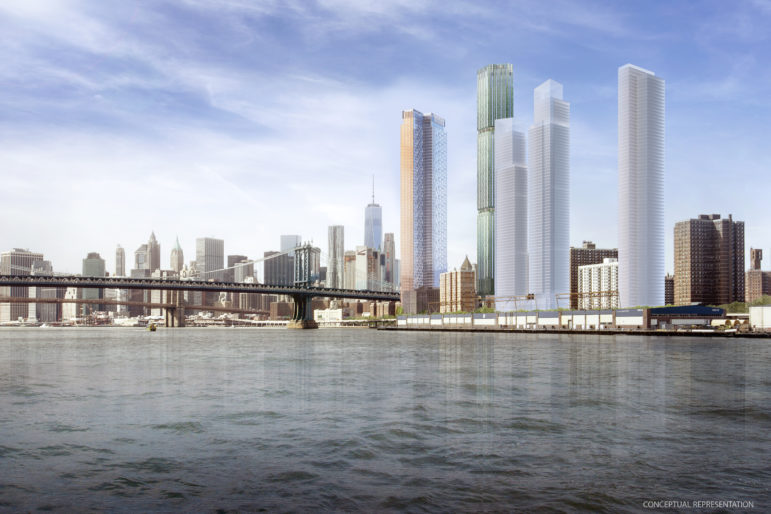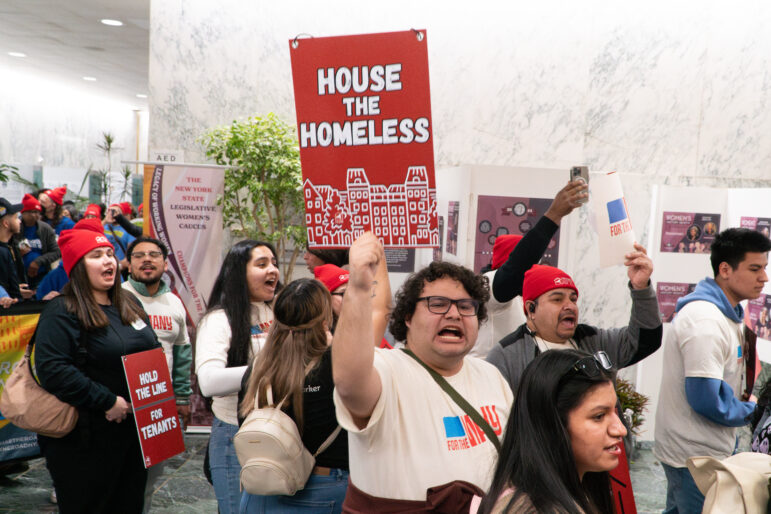
Handel Architects
A rendering of potential development in Two Bridges provided by the developers. Farthest left is the Extell tower, which is already nearing completion. The other four towers have yet to be approved and are the subject of the fight.
The Two Bridges community and elected officials are gearing up for a public hearing Wednesday on the controversial development application for four building sites that requests “minor modifications” to build larger developments in the area.
Over a dozen residents along with candidates for public advocate and state Senate rallied outside Sunday afternoon where Cherry and Rutgers Street meet in Two Bridges.
The community organization Lower East Side Organized Neighbors (LESON) said all four proposed development sites were illegal and that there would be no compromise on their end. LESON spokesperson said there were plans to sue the city and developers if the city moved forward and approved the application on the development sites.
Arnette Scott, a resident and activist, said the four towers would create shadows over the Jacob Riis public housing campus, block air flow into people’s homes and displace senior residents, “The fact is not about civil rights—athis is about human rights. [The city] is not telling developers that they have to compromise and we do not have faith in these leaders,” she said.
Currently, the Two Bridges area contains a six-story storage facility, a sports field, a pier and apartment buildings of varying sizes—the tallest is 26 stories. The zoning of the area with the apartment buildings is C6-4, which allows large-scale commercial or residential development with no height limit. This is where three developers are seeking to build four skyscrapers, the largest of which would be 1,008 feet high.
According the city’s environmental impact review, the proposed modifications would enable the development of three new mixed-use buildings. The “minor modifications” request would permit larger developments than are permitted under the previously approved Two Bridges Large-Scale Residential Development (LSRD) site plan. If the request is approved, the proposed buildings themselves would be larger and taller than the existing buildings in the surrounding area.
Two Bridges used to be an Urban Renewal Area, where the city sought to remove blight and create mixed-income housing and employment opportunities. In 1972, the area was designated as a Large-Scale Residential Development (LSRD) area, a district in which the city allows flexibility to normal land-use regulations in order to facilitate the most space-efficient and beneficial site plans for large apartment buildings that span multiple property lots.
According to the 700-page DEIS, the proposed projects include an 80-story tower at 247 Cherry Street, 62- and 70-story towers across from a residential complex at 260 South Street and a 63-story tower on a lot at 259 Clinton Street. In total, the projects would add 2,775 rental units in which 25 percent would be designated as permanently affordable and 200 of those would be set aside for low-income seniors. There would be about 11,000 square feet of retail space. The application for all the projects was filed jointly by three different developers.
LESON said that in LSRD zoning designation a construction project cannot interfere with the neighborhood character, restrict air and light access, create building bulk and traffic congestion.
“We do not compromise with breaking the law and with criminals. These towers break the law. If elected officials had the interest of the community in the mind then they would have stopped these towers. This is far from over and if the city decides to move forward and we are prepared to sue,” said David Tieu, member of the Chinese Staff and Workers Association and LESON. Tieu is an advocate for the original Chinatown Working Group plan, which was supported by a host of local groups and proposed a broad rezoning of the area to restrict development. The Department of City Planning in 2015 rejected that plan, which covered the waterfront and 111 blocks, as to ambitious—an argument Tieu rejects.
In previous reporting, the Department of City Planning told City Limits that activating the ULURP in the case of the four Two Bridges buildings was legally impossible because the developers were only asking for “minor modifications” to existing regulations. Councilwoman Margaret Chin and Borough President Gale Brewer have filed a zoning text amendment that would subject the three proposals to a full public review under the Uniform Land Use Review Procedure (ULURP) earlier this year. The zoning text amendment would replace the “minor modification” with a requirement that developers get a “special permit” to build in the area and allow properties. Special permits require a project to go through the ULURP process.
Brewer sent out an email reminder calling on residents to show up at the City Planning Commission public hearing scheduled for this week. “Although these proposals do not fit the context of the neighborhood or conform to the existing zoning code, the Department of City Planning decided to treat them as ‘minor modifications,’ which means they won’t need to go through a substantive public review process that would give the surrounding community a real opportunity to weigh in,” the email reminder said.
According to the DCP website, the City Planning Commission is allowed to modify the normal regulations using two, slightly different types of actions: “authorizations” or “special permits.” Brewer and Chin are calling instead for the use “special permits.” Applications for special permits under CPC jurisdiction generally concern use or bulk modifications with potential for greater land use impacts and special permits need to be approved through ULURP.
The Two Bridges development application public hearing is scheduled for Wednesday October 17, 2018 at 10:00 a.m. in the Hearing Room, Lower Concourse, at the City Planning Commission at 120 Broadway in Manhattan.









One thought on “Protest Ahead of Hearing on Proposed Two Bridges Skyscrapers”
Looks like the developer can build as of right. Apparently C6-4 zoning = R10 residential zoning. But I’m confused about something. A zoning change can be implemented by just changing the zoning text? Does that mean that the City Council can change the zoning of an area by simply changing the text? It’s unlikely but could the Council change the text to increase/decrease densities in residential areas without hearings, etc?
https://www1.nyc.gov/site/planning/zoning/districts-tools/c6.page